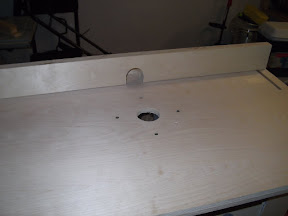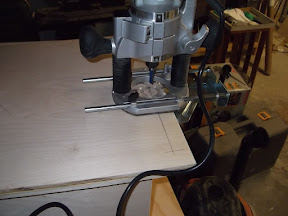Note: I originally posted this in July 2011 on another blog - I moved it here because I am putting all my garage and woodworking projects in one place.
When I was building the Garage Cabinet (which I am still happy with), I realized I needed a method to cut down large stock like plywood without using the bed of my pickup.
Awhile back I ran across
this page which had some renderings and pictures of exactly what I wanted to do. It referenced two other pages (
here and
here) with some extra details.
The plan was to build two sawhorses that could come apart for storage and portability along with a wood grid that could hold a 4'x8' sheet of plywood while it was being cut with a circular saw.
In the cabinet build I came across a deal at Home Depot where a sheet of 3/4" A/C plywood was $24. How can you pass that up? I picked up another sheet- which is all I would need for this project.
What is A/C plywood? One side is rated "A" grade which is the top grade without knots or defects while the other side is "C" grade which will have knots and filled in defects. This is for sawhorses- any grade would be fine but these sheets are solid and straight and cheep- so that is what I used.
Side One:

Side Two:

My cutting guide and list. It is basically all 4" strips of plywood.

I didn't do much in the way of plans this time. I am using the two detailed diagrams from the Wood Working Tips side linked above.
The first part was to cut all the strips. I set up the guide on my circular saw and went to town. The result is a lot of long thin plywood strips.

I then sized all of the pieces needed for the sawhorse legs. The legs are 35" long, the long braces are 21", and the short braces are 11".

Once that was out of the way, I set-up my chop saw to do a 15 degree cut. I put a stop block in a jig because basically every piece needed to be chopped at the end to 15 degrees.

Then it is time for some assembly. Gorilla glue and 1 1/4" screws all around. You will note that there is a vertical piece of scrap at the top. That is a spacer to ensure the stretcher will fit later on.

And the first sawhorse leg is done.

Repeat the same process three more times, and now we have four sawhorse legs.

Then I made up some 2"x4" cleats and attached them to the stretchers. This is what it looks like with the stretcher in place.

I repeated the process on the second stretcher and now I have two completed knock down sawhorses.

After I had an interview this morning, (it went very well, thank you for asking) I got cracking on the grid. The grid consists of two 8' long rails, two 4' long stretchers and the two saw horse stretchers made earlier. They will fit together with notches creating half-lap joints.
Here is the first of the sawhorse stretchers with the notch cut out and some layout marks for notches in one of the grid stretchers.


One I had cut the sawhorse and grid stretchers I realized I could make a small grid if I didn't need to use the whole thing. Nice.

Here is the full size grid all put together.

This grid is sturdy and large enough to hold basically any plywood or normal stock that I would come across. Given a sheet of plywood, this could also work as the frame for a portable workbench as well.
It fully collapses and can get pushed right up on the wall of my garage. I will probably figure out some way to hang it off the floor as well- but not today. Today I take a drink of cool water and enjoy my handy work. Then I get the broom and clean up...




























































